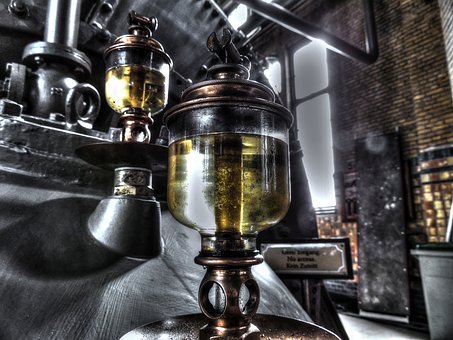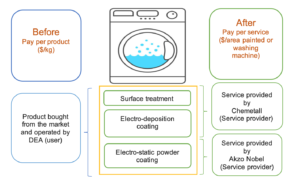
Picture credit : Pexels_Pixabay
Among a lot of the alternatives that we need to choose in order to move towards a circular, regenerative economy, the most impactful differences come from the redesign of upstream processes. Many of these involve a product or material redesign or larger industrial transformation.
There are some initiatives, which can create quick and easy wins in moving towards a circular economy. Initiatives such as product-service systems let you go a great length in achieving the fundamentals of a circular economy, just with the business model and process innovations.
Product Service Systems
Product-Service Systems (PSS) are defined as “a marketable set of products and services capable of jointly fulfilling a user’s need” (Goedkoop, 1999). The opportunities of application for these are endless while the service offering can be
- Result-Oriented – Seller sells access to a result that a product generates.
- Utility-Oriented – Seller sells access to the product for the extent of use.
- Use-Oriented – Seller sells access to the product over a period of time (e.g., length of use)
- Product-Oriented – Seller provides the product to the user and sells services to keep the product in use (e.g., access to repair, faulty product replacement)
| Ownership of the product | Aspect sold as the service | Light bulb example | |
| Result-oriented | Seller | Performance provided by the product | Area illuminated |
| Utility-oriented | Seller | Cycle of use of a product | No of hours/switch on-off cycles used |
| Use-oriented | Seller | Length of use of a product | No of months hired |
| Product-oriented | User | Repair services, Faulty product replacements, Warranty | Faulty bulb replacements and warranty |
With each of these options, the buyer and the vendor exercise various degrees of control and bears different types of risks over the same asset (or product) that provides a service to a consumer.
Chemical leasing
When Product Service Systems are applied to chemicals to focus on the performance aspect of it, rather than the chemical product selling, we call it chemical leasing. Chemical leasing provides the freedom to businesses and consumers to form models and business relationships, that focuses on improving the performance desired with the chemical to the user.
What problems does chemical leasing solve?
When it comes to the business of selling chemicals, the chemical supplier intends to make a profit by increasing their sales volumes. The higher the quantities of chemicals being manufactured, used, and sold; the higher the producer’s profits would be. The incentive they have to innovate to improve the performance of the chemical, reduce wastage, and release of waste chemical to the environment is only at their goodwill and discretion, and unlikely to happen with profit tied to the volumes sold.
On the other hand, the chemical user does not want the chemicals, but rather the service that is provided by the chemical. More likely, the user neither has the expertise to know the constituents nor the knowledge to think how to further innovate to reduce its use.
When the objectives of the producer and the user do not go hand in hand, they are in a “tug of war” working on optimizing their own gains as they define it. This is not an optimal solution neither financially or for the system as a whole, environmentally.

Picture credit: TheoRivierenlaan_Pixabay
What benefits does it bring?
Chemical leasing bridges this gap, by shifting the focus of the relationship from “selling the product” to “perform the use intended with the product” and get both the user and producer on one side, and drive them towards a single, unified objective – “increase the performance of the chemical for what it is used for and reduce the use and wastage”
When users only have to pay for the service, the producer being paid for performance is motivated to innovate to increase performance. The better the chemicals perform per unit quantity, the higher the savings are, therefore there is an incentive to improve the performance of chemicals individually, or collaboratively with partners to the upstream of the value chain. This is a unique way to motivate the producers to produce and sell less as their rewards do not decrease.
The chemical leasing model encourages the users and suppliers to break this barrier to come up with innovative and effective solutions together to achieve a common goal and exchange knowledge openly for mutual benefit. Long-term relationships that promote continuous improvement within the industry, providing better performance outcomes, as well as environmental outcomes, are the big pluses.
Additionally, instead of a one product fits all approach chemical leasing enables bespoke products and solutions.
Let’s look at a simple example of painting a house.
The house owner, who wants to have the house painted could buy paint and get a contractor to do it per hour or per job. The paint seller intends to sell more paint to make a higher profit and the left-over paint goes to waste.
If a performance-based approach is used, a contractor could be hired to pay per area painted. Chemical management is then carried out by the contractor providing the performance of the product. The contractor in this instance would urge the paint manufacturer to innovate further to increase the performance of the product per mass. , there is a strong incentive for innovation for product performance enhancement within.
More importantly, how the service for maintenance happens overtime can be tied up to the model. The supplier could provide maintenance to keep the product performance at a high-level with only the use of necessary chemicals. If there is an opportunity to recycle the chemicals at end of life, the supplier who has information of the product, know-how, and access to a network of specialists would do it than the consumer who makes a one-time purchase.
For a better understanding of the benefits of chemical leasing, let’s look at a real case study.
Evidence on how chemical leasing works
Chemical leasing was applied to washing machine manufacturing painting operations. The company, Delta Electrical Equipment (DEA), had control over the painting process which is important for high quality and durable products.
In order to achieve a high quality and durable washing machine, the painting process includes;
- Surface treatment
- Electro-deposition coating
- Electrostatic powder coating


It is evident significant performance outcomes, financial outcomes, as well as environmental outcomes, can be achieved through this model through reduced and more effective, and efficient chemical use. According to this example, the supplier was motivated to go for standards like REACH, creating ripple effects along the supply chain.
For more, case studies can be found on the UNIDO chemical leasing website for inspiration.
When we look back at some innovations, there are some obvious advantages that outweigh risks or challenges very easily. A look into our future, we could ask ourselves why we did not do these sooner.